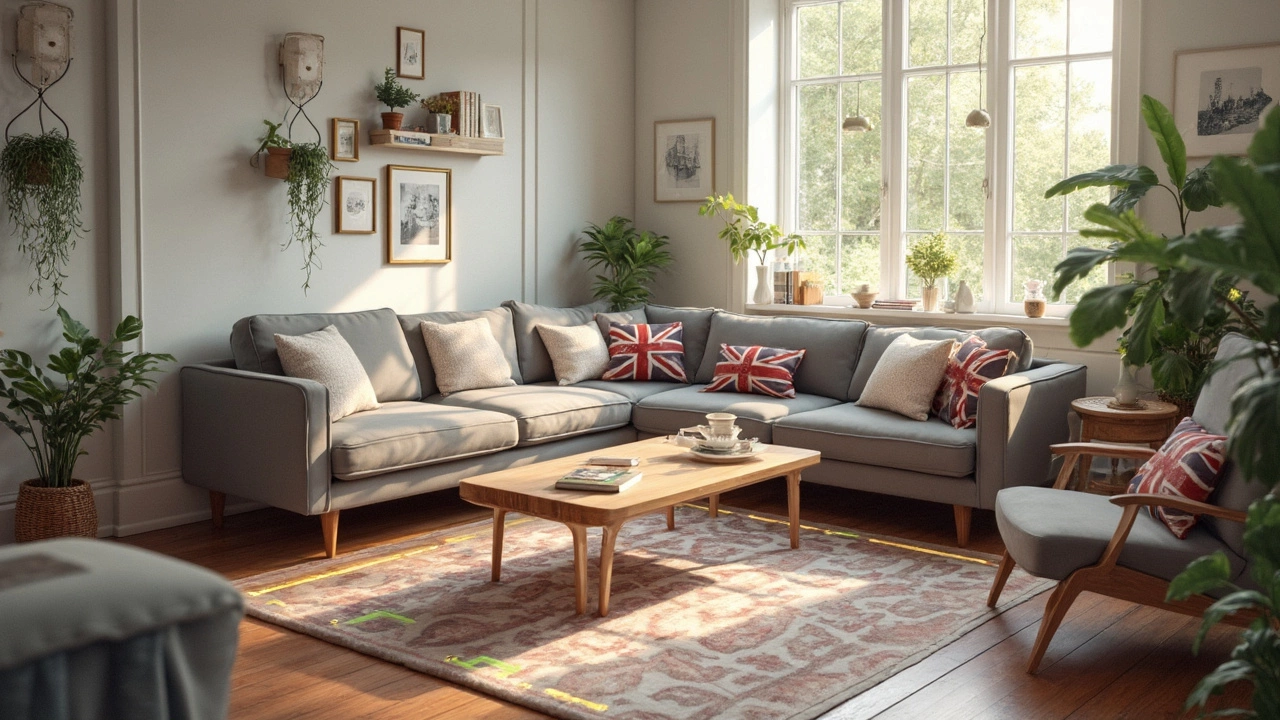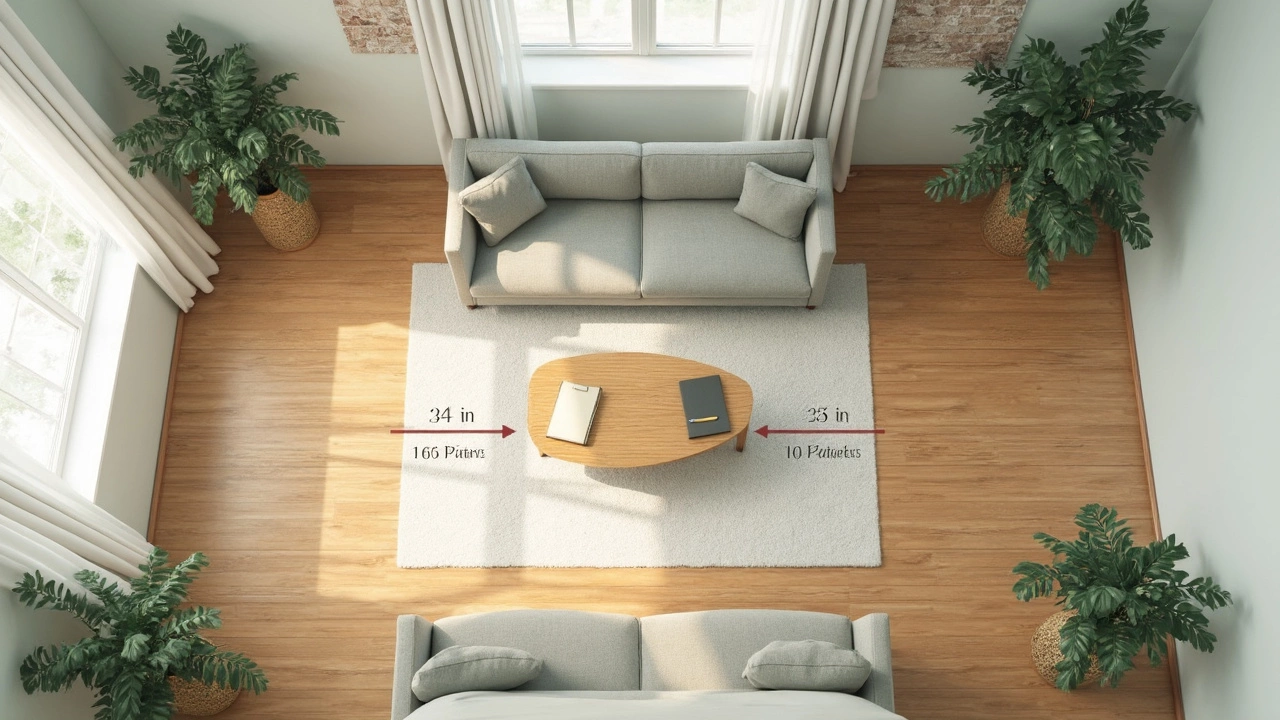
Here’s a question that gets more people stumped than you’d think: how far should your couch actually be from your coffee table? It sounds basic, right? But one wrong move, and you’re either bumping your knees every time you sit down or stretching like a yoga instructor just to grab your drink.
The sweet spot for most people is between 14 and 18 inches—yep, just a bit over a foot to a foot and a half. This pocket of space lets you reach snacks or the TV remote easily, but it’s still roomy enough to walk by without tripping up. If your space is tight, you definitely don’t want less than 12 inches, or it’ll just feel squished. Any more than 18 inches, and your table becomes a teetering island, way out of normal reach.
That gap between your couch and the coffee table isn’t just about looks—it’s what makes your living room work, or not. When you get the spacing right, you get easy access to your drinks, snacks, or phone, plus you avoid those annoying stubbed toes. If you get it wrong, sitting down, getting up, or just walking by turns into a daily struggle.
Here's the thing: most people use their living room for way more than just sitting. Kids play on the floor, friends pull up extra seats, and let’s face it, sometimes you eat an entire dinner in front of the TV. That little stretch of flooring between these two pieces of furniture sets the tone for all of it.
Physical comfort is a big deal here. Ergonomics experts say reaching more than 18 inches forward gets awkward fast. Too close—under 12 inches—means you can’t move your legs without banging into something, and the space starts to feel cramped. A sweet spot lets you kick back, stretch out, or slide past with no hassle.
Check out how most people set it up:
| Distance (inches) | What Happens |
|---|---|
| Less than 12 | Feels tight, hard to move feet, frequent bumps |
| 14-18 | couch and coffee table feel just right, easy access, no hassle |
| Over 18 | Table is a stretch, room feels disjointed |
Getting this space right isn’t just about design. It goes straight to comfort and how much you enjoy using your living room day to day. Even if your room is small or you’re working with giant furniture, keeping the right gap makes a world of difference.
If you want the gold standard for comfort and style, shoot for 16 inches between your couch and coffee table. It’s that simple number most interior designers fall back on—and it’s zoned in from everyday experience. At 16 inches, you won’t need to lean forward awkwardly or bump your shins every time you flop on the couch. You can easily walk through the space, rest your feet (if that’s your thing), and grab whatever’s on the table without doing any weird contortions.
Why 16 inches? Studies from home design pros like the American Society of Interior Designers (ASID) show that anything from 14 to 18 inches covers most people and most room sizes. Go closer than 14 inches, suddenly it’s tricky to stand up or shuffle past someone. Any more than 18 inches and your coffee table is probably just collecting dust.
Here’s a quick look at how those numbers shake out for real-life setups:
| Spacing | Best For | Room Size |
|---|---|---|
| 14 inches | Small apartments, narrow living rooms | Cozy (under 10x10 ft) |
| 16 inches | Average living rooms, everyday use | Standard (10x12 ft+) |
| 18 inches | Large coffee tables, busy homes | Spacious (15x15 ft+) |
One more thing: always measure from the edge of the seat cushion to the closest edge of the coffee table—not the back of the couch or table legs. The actual usable space is what matters.
For homes with toddlers or older folks, err on the wider side for safety. If you’re stuck with a unique-shaped table or a sectional that curves, just use the longest straight-line distance—that’ll keep movement smooth. And remember, the coffee table is probably the hardest-working piece in your living room, so making it easy to reach really is a game-changer.

Getting the spacing wrong between your couch and coffee table isn’t just an eyesore—it can mess with your whole living room vibe and even how you use the space. If there’s not enough space, you’ll quickly notice how annoying it is. You have to squeeze through, and anyone with long legs is going to bump their knees every time they sit down. People with kids or pets end up with spills and stubbed toes more often, too. More cramped space also makes your living room look cluttered and hard to keep tidy. If you’re always having to move the table just to sit or stand, something’s up with the layout.
On the flip side, if the gap is too wide, your coffee table turns into a useless prop. Want to grab your coffee from the couch? You’ll have to lean way forward, sometimes even stand up to reach it, which completely beats the purpose of having a convenient surface. If the gap is more than 18 inches, people just stop using the table the way it’s supposed to be used, and your living room loses that cozy, pull-it-all-together feel.
Here’s why the ideal distance matters so much for your couch and coffee table combo:
When the gap is wrong, it’s not just a design nitpick—it seriously affects how you live in your space. Next time you’re moving things around, grab a tape measure and shoot for that 14-18 inch goldilocks zone. You’ll feel the difference right away.
Not every living room is a cookie-cutter. Got weird angles, narrow walkways, or just not much space at all? Good news—there are hacks for squeezing in both style and comfort, even if your couch and coffee table don’t fit the textbook mold.
First, if your coffee table feels like it’s eating up all the room, swap it for something slimmer. Glass tops and tables with open sides don’t just look lighter, they actually give you more space to move around. If you don’t want to ditch your big table, try pulling your couch an inch or two closer to the wall and see if you can snag a few more inches of walk space without cramping your setup.
Another trick: try a couple of small nesting tables instead of one big table. They tuck away when you don’t need them and can be split up for drinks or snacks at movie night. Storage ottomans work, too—they can double up as extra seats or a spot to stash remotes and games, plus they’re easy to scoot around.
If your room is super tight, floating shelves or wall-mounted drop-leaf tables give you a place to put your stuff without sticking out into your walking path. You can flip them out when you need extra space or tuck them away to regain floor space.
Getting creative with furniture placement helps, but here’s what actually works in homes, based on a survey in 2024 of 300 American apartments:
| Room Size | Average Distance Used | Most Popular Fix |
|---|---|---|
| Small (<120 sq. ft.) | 12-14 inches | Nesting tables |
| Medium (121-180 sq. ft.) | 16 inches | Storage ottomans |
| Large (>180 sq. ft.) | 18 inches | Full-size coffee table |
One last thing: don’t forget about corners and unused edges—corner tables or C-tables (the ones that slide right up to the sofa) can act as mini versions of a traditional table if you’re really pinched for space. Fitting your living room together is a bit like Tetris, but with the right moves, there’s nearly always a way to make it comfortable.
Write a comment